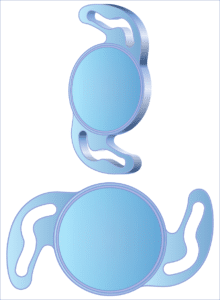
At Milwaukee Eye Surgeons in Brookfield, WI, board-certified, fellowship-trained ophthalmologist Dr. Kenneth Weinlander and our team offer patients throughout Southeast Wisconsin access to modern intraocular lens (IOL) technology. Dr. Weinlander performs cataract surgery in our state-of-the-art surgical suite, making it more affordable, convenient, and easier to schedule for patients from Waukesha and Menomonee Falls.
One of the most important things to discuss with Dr. Weinlander before surgery is the choice of replacement lens. Trifocal and EDOF IOLs are both excellent options, but they work differently. Read on to compare them.
Understanding Trifocal Lenses
Trifocal, also called multifocal, lenses are designed to provide clear vision at three distinct focal points: near, intermediate, and distance. This technology divides light to deliver smooth visual transitions, allowing patients to comfortably read, drive, and use digital devices without needing to switch between different glasses.
Many patients appreciate that trifocal lenses minimize dependence on corrective eyewear and provide crisp, vivid vision in various lighting conditions.
Due to their design, modern trifocal lenses are particularly well-suited for patients seeking complete visual freedom after cataract surgery. They help reduce the halos and glare sometimes associated with older lens designs, offering better performance in both bright and dim light environments.
Understanding EDOF Lenses
EDOF, or extended depth of focus lenses, create a continuous range of vision rather than separate focal points. This smooth transition allows patients to see clearly at intermediate and distance ranges, making EDOF lenses ideal for everyday tasks like driving, computer work, and watching television.
While reading glasses may still be necessary for fine print, EDOF lenses typically offer superior night vision and fewer visual disturbances compared to multifocal options.
These lenses work by extending the focus of light entering the eye, offering a natural visual experience that feels less “split” than traditional multifocal designs. Patients often describe the results as comfortable, consistent, and adaptable across multiple daily activities.
Choosing the Right IOL For You
Both trifocal and EDOF lenses offer excellent outcomes, but the best choice depends on your lifestyle, vision goals, and tolerance for potential visual side effects.
During your personalized cataract consultation, Dr. Weinlander discusses your unique vision needs, evaluates your eye health, and discusses the lens that can provide the best possible vision post-surgery.
To learn more about advanced lens replacement options and cataract surgery, schedule an appointment with Milwaukee Eye Surgeons in Brookfield, WI.

